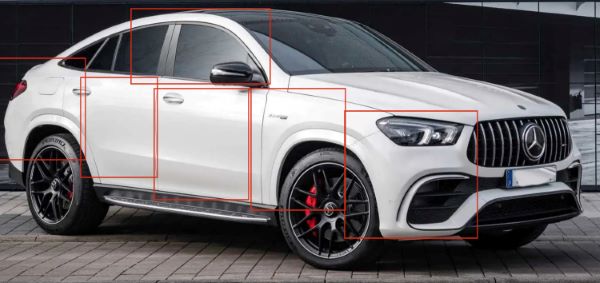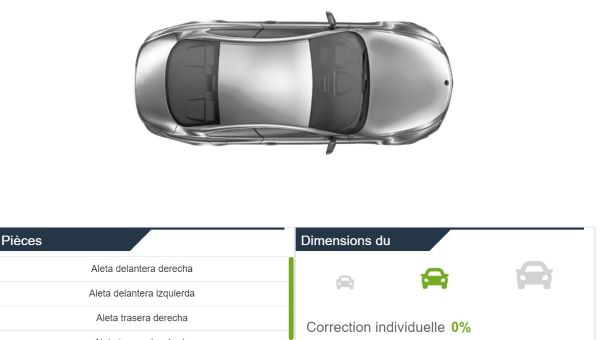 Paint consumption and yield – Calculate your need for each project
Paint consumption and yield – Calculate your need for each project
Carrying out painting on a vehicle or any other type of support requires different products, such as primers, undercoats, paints, clearcoats, etc. This article is intended to answer questions about the needs in quantities of paint, pure or after mixing and dilution to carry out different types of projects.
→ Consumption depends on the type of paint or product, and the thickness that must be applied to the support. A primer, a paint, a 2K paint, a clearcoat have different consumption. This theoretical consumption or yield is approximate, because each shade is unique and may have different covering power.
→ Technical support will be able to tell you what you need to carry out a touch-up or a complete painting, depending on this or that type of paint.
Paint calculator: how to estimate the surface area of a vehicle or part?
♣ To find out how much paint you need, the first thing to do is to estimate very roughly the amount of surface to be painted, always rounding up, without trying to be precise.:
All you have to do is visualize a square metre and quickly transfer it visually to the surface of the vehicle in front of you, then multiply it by measuring the approximate length and width..
If you have a round part, just imagine a 1 m² tablecloth covering the entire part. For small rooms, you can count on a “half tablecloth”, i.e. ½m² = 0.5m², or 2/3m² = 0.66 m² or even 1/4m² = 0.25m²..
► See below for yields and consumption figures for spray paint (aerosols)
Needs and consumption by type of parts
In Liter ready to use (already mixed)
► AUTO color code paints
|
m² |
Primer * |
Paint |
Clearcoat |
|
|
car fender |
0,75 |
0,25 L |
0,25 L |
0,25 L |
|
Door |
0,75 |
0,25 L |
0,25 L |
0,25 L |
|
Hood |
2 |
0,50 L |
0,50 L |
0,50 L |
|
1 Exterior car rim |
0,5 |
0,15 L |
0,15 L |
0,15 L |
|
Mudguard |
0,5 |
0,10 L |
0,10 L |
0,1 L |
|
Tank |
0,75 |
0,15 L |
0,15 L |
0,15 L |
|
2 sided motorcycle rim |
0,75 |
0,15 L |
0,15 L |
0,15 L |
|
Helmet |
0,66 |
0,125 L |
0,125 L |
0,125 L |
Minimum and general quantities are indicative
Needs and consumption according to types of vehicles and supports
In Liter of pure product (thinner or hardener not included)
|
m² |
Primer |
Paint |
Clearcoat |
|
|
city-dweller car |
12 - 15 |
1 – 2 L |
1 – 2 L |
2 L |
|
Saloon car |
20 |
2 L |
2 - 3 L |
2 L |
|
4x4 |
25 |
2 - 3 L |
3 – 4 L |
3 L |
|
Camping Car / Van |
40 – 50 |
3 - 4 L |
4 – 6 L |
4 – 6 L |
|
Moto roadster / cruiser |
p>1 – 2 |
0,5 L |
0,5 L |
0,5 L |
|
Sports/road motorcycle |
3 - 4 |
1 L |
1 L |
1 L |
|
Jet Ski |
p>3 |
0,5 L |
0,5 L |
0,5 L |
|
Bike |
1 |
0,2 L |
0,2 L |
0,2 L |
Minimum and general quantities are indicative
Needs and consumption by type of tubular parts
Quantity of ready-to-use products (already mixed with hardener and thinner).
|
Primer |
Paint |
Clearcoat |
|
|
Motorcycle chassis / quad |
0,5 L |
1 – 2 L |
|
|
Chassis 4x4 |
1 L |
2 - 3 L |
|
|
Portal (3m) |
1 - 2 L |
3 – 4 L |
|
|
Bike |
0,25 L |
0,3 L |
0,3 L |
The yields of spray paints
Aerosols are extremely practical packaging because they allow you to paint without the need for a compressor or a gun and eliminate the need for cleaning, etc. Their prices seem attractive. However, it must be understood that paint requires propellant gas to be sprayed. Propellant gas constitutes approximately 75% of the aerosol volume.
Here are the actual product contents in the aerosols.
All primers, paints and clearcoats 1K (one-component): 100ml
All 2K primers, paint and clearcoats (two-component): 150ml *
(The hardener component is not pigmented and does not contribute to the paint’s covering power.).
|
Yield for 1 coat |
||
|
1 primer spray |
1 spray paint |
1 clearcoat spray |
|
≈ 1m² |
≈ 1m² |
≈ 1m² |
|
m² |
Primer |
Paint |
Clearcoat |
|
|
Moto roadster / cruiser |
1 – 2 |
2 |
3 |
3 |
|
Sports / road motorcycle |
3 |
3 |
4 |
4 |
|
JetSki |
3 |
4 |
5 |
4 – 5 |
|
Quad |
1 |
1 – 2 |
2 – 3 |
2 – 3 |
|
Bike |
1 |
1 – 2 |
2 – 3 |
2 – 3 |
Primer requirements depend on the condition of the vehicle's surface.
Consumption of primer, paint and clearcoat
► Primers have very variable yields:
A filling primer is designed to fill in thickness and, depending on the number of coats applied, the final consumption can be from 2.5 to 10 m² per Liter. Recommended thickness: 50-150 µm
An adhesion primer, on the contrary, must be applied in a thin layer to better adhere: the final yield can reach 10 m² with 1 Liter. Recommended thickness: 25µm
► Paints
Automotive or motorcycle color code paints or special effect paints generally have final consumption of around 4 to 5 m² / Liter of ready-to-use product. Pearl and metallic paints generally have less coverage than simple opaque colors.
► Clearcoats
UHS automotive topcoats have a very stable yield of around 5-6 m² / Liter of ready-to-use product. Recommended thickness: 50 µm
► Yield in m²/L
Consumption is expressed in L (liter) or KG (kilos) per M² (square meter):
♦ is finished (All coats necessary until complete coverage) .
♦ or per coat (Consumption for one coat).
 How to know the need on the technical sheet?
How to know the need on the technical sheet?
The basic information to know the covering power or the performance of a given paint is always indicated on an information page of the product or on its technical sheet. There are two things to take into account on a technical sheet to know the paint consumption:
► Consult the product page and look at the yield per meter². The yield is expressed either in 1 coat or in total/final.
Example:
Ready-to-use pearlescent paint: 10m² / L in one coat or Ready-to-use pearlescent paint: 5m² / L final
When the yield is expressed in a single coat, then simply divide it by 2 (coats) to obtain the total final yield. If a paint must be applied in 4 coats, then divide 10 m² by 4 = 2.5 m² / L to obtain the final yield.
► Pure or Ready to use?
Depending on the manufacturers, the technical sheet indicates a yield for the pure product (without the hardener or thinner) or the ready-to-use product (mixed with its hardener and thinner and ready to spray).
Examples:
1 L of pure clearcoat = 12 m² / 1 coat
or
1 Liter of ready-to-use clearcoat* = 8m² / 1 coat
*(600ml of clearcoat + 200ml of hardener + 200ml of thinner)
♣ The theory
Sometimes, on a technical sheet, no yield in square meters / Liter is indicated. Instead, there is a suggested wet thickness and consumption in grams per square meter (g/m²). The thickness method is reserved only for manufacturers or professionals equipped with a “measuring comb” for the thickness of paint layers.
The dry thickness is logically deduced as follows: 1 kg of paint is applied to 10 m² or 100g/m². This paint has a VOC rate of 50% (volatile material), It will therefore remain 50 g/m² or 50µm thick. This final suggested quantity, which is the thickness in microns on the surface, must of course be applied in several coats to avoid drips.



















































































